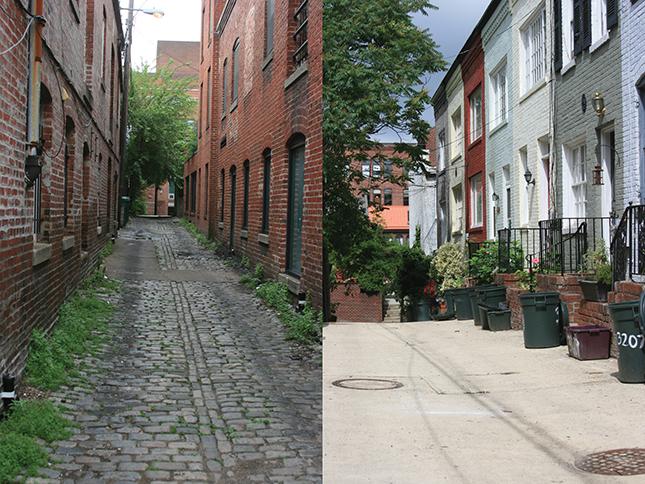Georgetown to City’s Rats: Look Out
By • June 18, 2013 0 2331

On May 25, the Georgetown BID’s Street Operations Manager Alfred Corbin, joined by District Department of Health reps and around 10 residents and business owners, led a public walk-through of the claustrophobic Cherry Hill Lane to show off the city’s latest efforts in rodent abatement. The cobbled, elbow-shaped nook wends through that forgotten part of west Georgetown, just off lower Wisconsin — it’s silent, shaded and carved from long-shuttered factories and defunct restaurants.
The alley, or at least part of it, may also be the paragon of pest-free living in Georgetown.
Rodent and insect control is one of those dirty, furtive little responsibilities of living with no place in polite conversation, making the Tuesday morning gathering seem a little taboo. Polite handshakes circled around, eye contact was sparse. There was an overwhelming expectation to hear someone jokingly drawl, “Let’s go find us some rats!”
That any irreverence was kept in check is a testament to the project’s seriousness — this is, after all, a neighborhood perched over a major river and pervaded by capillary roads closed to traffic and ripe for infestation. Staying on top of Georgetown’s delicately termed “rodent problem” requires the city to mandate strict preventative measures and hold residents and business owners accountable to them. For the extra cautious — or militantly anti-rodent — there’s the walk-through program, which shows firsthand how basic prevention can greatly impact sanitation and pest deterrence.
Arcing between Grace Street and Cecil Place, Cherry Hill Lane is a study in before-and-after dualism. Entering from Grace Street, amblers on foot immediately rattle down a dark strait of overgrown pavestones, tepid water and hugely blooming weeds — the perfect spawning conditions for rats and mosquitoes, pointed out Gabe Curtis, a city pest controller with DOH, on the walk-through. The alley — little more than the backside of a row of Wisconsin Avenue eateries — isn’t heavily trafficked, but pest populations, proliferous by nature, can spread outward at an alarming rate from a single spawn point.
Turn the corner, however, and the scene is suddenly less grim, the stonework brighter. A white concrete easement, troughed to shunt away standing water, has replaced the oil slick-colored cobblestones. Herbs grow unnibbled in the garden soil. Garbage pails, tethered to iron railings and lampposts, are sealed neatly. Having just seen the alley’s ugly step-sibling, the walk-through group was impressed. Curtis, who spoke of the urban rat problem with a sort of Ghostbuster-like nonchalance, credited the efforts of both the city and neighbors.
“The problem on this end is practically solved. Everybody took ownership,” he said.
Corbin reiterated the point, going on to deliver a sort of anti-rat manifesto, part biology lecture and part deconstruction of the rodent mind.
“If they don’t have all the elements they need to survive, it creates a stress situation … If you remove all the elements, you end up with what you see here,” he said, gesturing around.
The take-home was that it’s a collaborative effort — the city can tidy up infrastructure and install traps, but the real onus lies with residents, who must preserve an inhospitable environment for the city’s furry and six-legged nuisances. The lesson was well taken. The walk-through-goers looked around, scribbled notes. Someone dumped an overturned garbage lid filled with stagnant water. The age-old battle of urban living seemed to be drafting some new combatants.
Still, the work is far from over for the Department of Health. Curtis said the rodent population enjoyed a resurgence this year, following the chaos of the February blizzard (which also yielded unusually high moisture levels). Traps baited with the rodent toxin diphacinone serve as a temporary solution, but city pest controllers are careful about installing them before ensuring the safety of their placement, especially in residential corridors. Street rehabilitation, repaving especially, is proving to be a headache for the city and residents alike, too. In the end, progress is slow: the next “expansion,” as the DOH terms it — slated for the 1400 block of Upper Wisconsin Avenue — isn’t scheduled to begin until 2011.
But as the walk-through showed neighbors, they needn’t wait around until then.
Tips for keeping rodents out of sight and out of mind:
1. Store garbage in metal or heavy plastic containers with tight lids.
2. Remove weeds and debris near buildings and in yards. Don’t give rats a place to hide.
3. Don’t leave extra pet food exposed. Instead, store it in a secure container.
4. Inspect your basement and house for cracks and holes, and seal them with mortar.
5. Make sure you have screens on your windows and inspect them regularly for holes.
(Source: doh.dc.gov)

